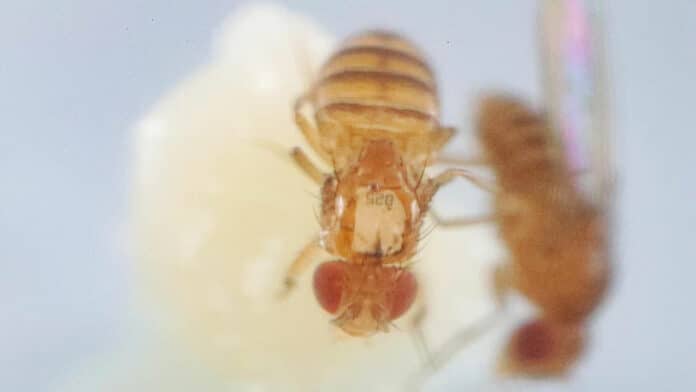The dynamics and connectivity of neural circuits continuously change on timescales ranging from milliseconds to an animal’s lifetime. Therefore, to understand biological networks, minimally invasive methods are required to record them in behaving animals repeatedly.
Scientists at EPFL have developed an implantation technique that allows unprecedented optical access to the “spinal cord” of the fruit fly, Drosophila melanogaster.
Scientists have been digitally trying to recapitulate the principles underlying Drosophila motor control. In 2019, they developed DeepFly3D– a deep-learning-based motion-capture software that uses multiple camera views to quantify the 3D limb movements of behaving flies. In 2021, they developed Ramdya’s team revealed LiftPose3D– a method for reconstructing 3D animal poses from 2D images taken from a single camera.
These efforts were complemented by their publication in 2022 through NeuroMechFly– the first morphologically accurate digital “twin” of Drosophila.
But there are always more challenges ahead. The aim is not just to map and understand an organism’s nervous system – an ambitious task in and of itself – but also to discover how to develop bio-inspired robots that are as agile as flies.
Ramya said, “The obstacle that we had before this work was that we could only record fly motor circuits for a short period of time before the animal’s health deteriorated.”
Hence, EPFL’s School of Engineering scientists developed tools for monitoring Drosophila neural activity for longer periods.
Laura Hermans, a Ph.D. student who spearheaded the project, said, “We developed microengineered devices that provide optical access to the animal’s ventral nerve cord. We then surgically implanted these devices into the fly’s thorax.”
“One of these devices, an implant, allows us to move the fly’s organs aside to reveal the ventral nerve cord below. We then seal the thorax with a transparent microfabricated window. Once we have flies with these devices, we can record the fly’s behavior and neural activity across many experiments over long timespans.”
These tools enable prolonged observation of a single animal by scientists. Now, they can conduct studies that last for days or even the entire fly’s life, rather than just a few hours.
Hermans said, “For example, we can study how an animal’s biology adapts during disease progression. We can also study changes in neural circuit activity and structure during aging. The fly’s ventral nerve cord is ideal because it hosts the animal’s motor circuitry, allowing us to study how locomotion evolves over time or after injury.”
Selman Sakar said, “As engineers, we crave well-defined technical challenges. Pavan’s group has developed a dissection technique to remove the organs from the fly that block the field of view and visualize the ventral nerve cord. However, the flies can only survive for a few hours after the surgery. We were convinced that an implant had to be placed within the thorax. There are analogous techniques for visualizing the nervous system of bigger animals such as rats. We got inspiration from these solutions and started to think about the miniaturization issue.”
Early designs attempted to solve the problem of retaining and safely removing the fly’s internal organs to expose the ventral nerve system while allowing the fly to survive after surgery.
Sakar said, “For this challenge, you need someone who can approach a problem with both a life sciences and engineering perspectives –this highlights the importance of Laura’s [Hermans] and Murat’s [Kaynak] work.”
Only a few flies survived the initial implants because they were stiff. It required multiple design changes to increase survival rates without degrading the imaging quality. The winning design- a V-shaped compliant implant that can securely move the fly’s organs aside and reveal the ventral chord, is simple yet effective. This enabled scientists to seal the hole on the cuticle with a “barcoded thoracic window,” which allows them to observe the ventral nerve cord and make measurements of the neuronal activity as the fly goes about its daily life.
Sakar said, “Considering the animal-to-animal variations in anatomy, we had to find a safe and adaptive solution. Our implant addresses this particular need. We provide a versatile toolkit for neuroscience research, together with developing proper tissue micromanipulation tools and a 3D nanoprinted compliant stage for mounting animals during repeated imaging sessions.”
Ramya said, “By studying the fly, we believe that understanding something relatively simple can lay the groundwork for understanding more complicated organisms. When you learn mathematics, you don’t dive into linear algebra; you learn how to add and subtract first. Additionally, for robotics, it would be fantastic to understand how even a “simple” insect works.”
“The next step for the team is to use their new methodology to unravel the mechanisms of Drosophila movement control. Biological systems are unique compared to artificial systems in that they can dynamically modulate, for example, the excitability of neurons or the strength of synapses. So to understand what makes biological systems so agile, you need to be able to observe this dynamism. In our case, we’d like to look at how, for example, motor systems respond over an animal’s lifetime to aging or during recovery following injury.”
Journal Reference:
- Laura Hermans, Murat Kaynak, Jonas Braun, et al. Micro-engineered devices enable long-term imaging of the ventral nerve cord in behaving adult Drosophila. Nature Communications, 25 August 2022. DOI: 10.1038/s41467-022-32571-y
